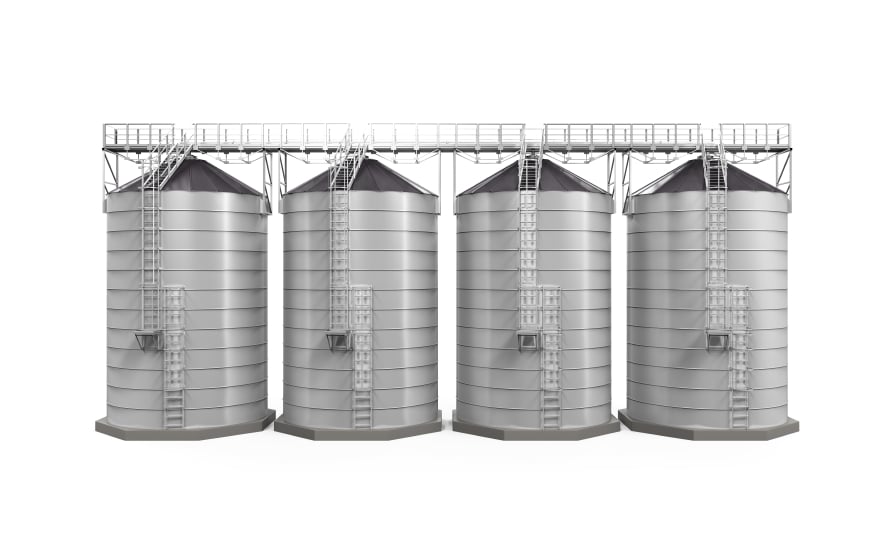
Siloing is a way of organizing your website to create a user-friendly content map. This makes it easier for users to navigate your site, and it helps search engines crawl your website for ranking. In the guide below, we will explore what SEO silos are and how you can benefit from using them.
What Is an SEO Silo?
In agriculture, a silo is a large structure used to contain grain, feed, or other types of products. Each silo holds a specific type of product in complete containment. Woodchips don’t go in the grain silo, and grain doesn’t go in the sawdust silo.
An SEO silo serves the same purpose on a digital level. It “contains” similar themes on a website, rather than tangible items. Webpages that follow the same theme are grouped together in a single, all-inclusive silo that does not dip into any other silo on the website.
To put matters into perspective, let’s say that you run a business selling dog food. You have two main categories of dog food: wet and dry. For your SEO silo structure, you may have a silo of webpages dedicated to wet dog food and a silo of webpages dedicated to dry dog food. These two silos would only link within themselves, not to the other silos on the website.
Benefits of the SEO Silo Structure
SEO silos serve several purposes:
- Create a logical content organization system that groups like concepts together.
- Establish the website as an authority for a specific theme (the theme of the silo).
- Build individual content groupings that can be monitored, adjusted, expanded, or removed as needed.
- Gain a clear vision of the purpose of the website and how well it currently reaches the target audience.
- Reorganize content on the website that is disjointed, unrelated, or valueless.
- Provide search engines and visitors with a clear map of website content.
- Encourage users to stay on the website by moving within the silo.
Think of this like you would bagging your groceries at the supermarket. If you put all the cold items together and all the canned foods together, you have an easier time finding what you need when you go to put up your food. In this case, you are simply “bagging” similar pieces of content so it is easier for search engines to find them.
Not only do the silos create a clear path for search engines to follow when crawling your website, but they also boost your credibility for specific search terms (often the themes of your silos). By having several pieces of content all backing the same central theme, your website will appear as a more valuable resource that Google and other search engines will want to promote.
Types of SEO Silos
There are two main types of SEO silos: physical SEO silos and virtual SEO silos. Both of these can result in the boosted search engine rankings, but they accomplish that in different ways.
A physical SEO silo affects the site’s directory and URL structures of pages on the site. Each silo has a parent page and multiple child pages. The URL for the parent page will be: WebsiteName.com/parent-age. The URLs for the child pages will be WebsiteName.com/parent-page/child-page.
With a virtual silo, connections within the silo are established through interlinking. Each child page links back to the parent page, and the parent page links to all the child pages. The child pages within the silo should also link to one another, creating a clear grouping on the website.
How to Create an SEO Silo Structure for Your Website
In order to create an SEO silo structure for your website, you first need to identify the themes for your silos. You can always expand your silos later on, so keep it simple at first. In the dog food case above, our two silos were Wet Dog Food and Dry Dog Food.
Each silo should have a minimum of five supporting pages, in addition to a parent page or category page that represents the main theme for the silo. For the dog food site, we may have:
- Wet Dog Food Category Page
- Chicken Flavored Wet Dog Food
- Quail Flavored Wet Dog Food
- Turkey Flavored Wet Dog Food
- Salmon Flavored Wet Dog Food
- Beef Flavored Wet Dog Food
- Dry Dog Food Category Page
- Chicken Flavored Dry Dog Food
- Turkey Flavored Dry Dog Food
- Beef Flavored Dry Dog Food
- Pork Flavored Dry Dog Food
- Deer Flavored Dry Dog Food
Whether you use a physical or virtual silo structure, you can group like pages together to establish themes on your website. From there, you can choose to expand your existing silos or create new silos underneath your existing ones, depending on what works best for your site. Keep the silo structure in mind with every piece of content you create, and you should see a significant improvement in your search result rankings.
How to Link between Different Silos
If you want to link between two different silos, link to the category page for the new silo. In the example above, some of the flavor profiles overlap between categories. Even though it may make sense to link the chicken flavored wet and dry dog food pages, that would harm the integrity of the silos. It would be better to link to the category page to indicate a transition to a new silo.
If you need help optimizing your site structure, Detroit Internet Marketing offers website repair services. We’ll evaluate your existing site organization to eliminate broken links, faulty navigation and confusing connections. With over 15 years of experience in web design and SEO, our digital marketing company is well-equipped to improve your website.
Call (248) 234-4830 to schedule your free digital marketing consultation.